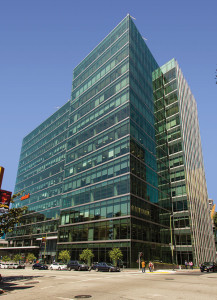Ancient Meets Modern Ingenuity in an Unprecedented Seismic Solution
Tipping Structural Engineers was an Outstanding Award Winner for the 680 Folsom Street project in the 2014 NCSEA Annual Excellence in Structural Engineering awards program (Category – Forensic/Renovation/Retrofit/Rehabilitation Structures).
The transformation of 680 Folsom – an uninspiring steel-moment-framed building originally completed in 1963 – into desirable office space is an Ugly Duckling story with a commercial-development fairy-tale ending. The building, formerly owned and occupied by Pacific Bell until 2007, stood empty and obsolete in San Francisco’s South-of-Market neighborhood, an area otherwise buzzing with redevelopment. The developer saw an opportunity to attract coveted tech clients by upgrading the 12-story, concrete-clad, asbestos-filled “Class C” building to 14 stories with a “Class A” rating. Successfully doing so necessitated a complete overhaul – upgrading the structure’s seismic performance, replacing the drab precast skin with a sleek glass curtain wall, and expanding the space vertically and horizontally. Like many projects at the time, 680 Folsom’s ambitious rehabilitation fell victim to the Great Recession, which forced a hold in 2008 and a value-engineering redesign in 2010. However, by February 2011, even before construction had started, 85 percent (420,000 square feet of the building) had already been leased.
In a quest to design a cost-efficient seismic retrofit scheme that would meet the budget and performance criteria set by the developer, Steven Tipping of Tipping Structural Engineers (formerly Tipping Mar) reached centuries back and an ocean away to medieval Japan for design inspiration. The result? A unique isolative lateral system, unprecedented in modern engineering, that proved valuable to the owner, architect, and general contractor.
The novel design solution was inspired by the structure of the ancient Japanese pagoda. In this architectural tradition, dating as far back as the seventh century, an entire tree trunk (or shinbashira) forms a central spine that rests in a stone well, the well providing a pivot point for the trunk. Wooden brackets loosely connect each of the pagoda’s floors to the spine. During a large earthquake, the shinbashira acts as a mode shaper; it pivots freely in its stone well and dictates a more uniform displacement at all floors, allowing seismic forces to dissipate along the full height of the structure, which then returns to plumb.
How was all this accomplished? A combination of good “bones,” creative thinking, and performance-based design set things in motion. Constructed as a bolted-flange moment space frame, 680 Folsom possessed some exceptionally good structural qualities that the design team could use. The original seismic system employed moment connections at every column-girder connection, providing a very redundant system. In addition, the bolted-flange connections gave the structure a high degree of ductility and rotation capacity. (The building, however, did not meet the global drift requirement of a new structure.)
During a 2010 value-engineering redesign, the original seismic retrofit solution consisting of two I-shaped core walls gave way to a new study exploring the possibility of a modern shinbashira: a single, rocking 30-foot-square concrete core located in the center of the building, where the elevator shafts are housed. The preliminary findings from the study proved promising and showed that the existing moment frames, when forced by the core to displace uniformly, possessed the redundancy and ductility to resist lateral forces. The engineers then focused on detailing the base of the new mode-shaping core to act as a pin-base connection.
A number of connection details were explored but were jettisoned in favor of a single friction pendulum bearing that would support the base of the concrete core. This base connection has a number of structural benefits: it isolates the core’s 232-foot, 8-million-pound gravity load to one location during a seismic event; provides a virtual pivot point for the core at the stiff first floor; and, does not require any overturning moment capacity at the foundation level. In this modern shinbashira, the friction pendulum is analogous to the stone well.
For this detail to work, however, the 30-foot square core had to be sculpted down to rest on the bearing’s 5-foot by 5-foot steel housing. A deep concrete beam, or “sacrum,” measuring 12 feet deep by 12 feet wide, was designed to span over the friction isolator and transfer all of the gravity loads from the concrete core into the friction bearing. The bearing, stabilized in its cast-steel housing, measures 3.5 feet in diameter and slides freely in its bowl-shaped base, much in the same way that the shinbashira is free to rotate in its stone well. The entire structural assembly is founded on a relatively shallow, 15-foot wide by 15-foot long by 7-foot deep pile cap foundation system; 30 micropile elements provide the gravity support.
The single rocking core harnesses the strength of the existing moment frame by forcing yielding throughout the frame’s height, thereby redistributing seismic deformations throughout the structure. In addition, horizontally placed buckling restrained brace (BRB) elements – analogous to the wooden brackets that loosely join a pagoda’s floors to the shinbashira – link the floors to the core and limits load transfer between the systems.
In summary, Tipping’s modern shinbashira greatly benefited the owner, architect, and builder by providing 680 Folsom with a building performance that was tuned to match the 1.7 percent (DBE) drift limit of the new curtain wall, chopping ten weeks off the construction schedule, saving $4 million on a $110-million project, lowering earthquake-insurance premiums, allowing greater architectural freedom, and increasing leaseable space. When it was complete, Jones Lang LaSalle’s International Director David Churton referred to the rehabilitation of 680 Folsom as “the ultimate repositioning and renovation in San Francisco history.”▪

